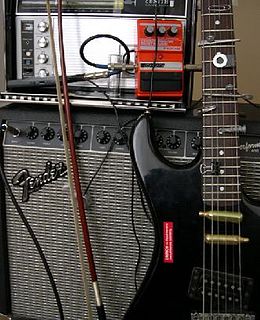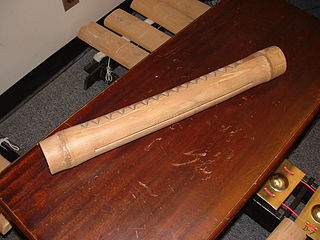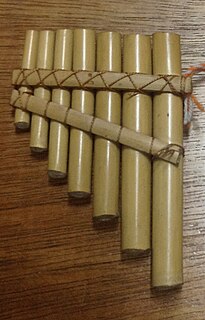An instrumental is a musical composition or recording without lyrics, or singing, although it might include some inarticulate vocals, such as shouted backup vocals in a Big Band setting. Through semantic widening, a broader sense of the word song may refer to instrumentals. The music is primarily or exclusively produced using musical instruments. An instrumental can exist in music notation, after it is written by a composer; in the mind of the composer ; as a piece that is performed live by a single instrumentalist or a musical ensemble, which could range in components from a duo or trio to a large Big Band, concert band or orchestra.
Throughout history, various methods of musical instrument classification have been used. The most commonly used system divides instruments into string instruments, woodwind instruments, brass instruments and percussion instruments; however, other schemes have been devised.
A membranophone is any musical instrument which produces sound primarily by way of a vibrating stretched membrane. It is one of the four main divisions of instruments in the original Hornbostel-Sachs scheme of musical instrument classification.

The Roland TR-808 Rhythm Composer, commonly known as the 808, is a drum machine manufactured by the Roland Corporation between 1980 and 1983. It was one of the first drum machines to allow users to program rhythms instead of using preset patterns. Unlike its nearest competitor at the time, the more expensive Linn LM-1, the 808 generates sounds using analog synthesis rather than playing samples.

Steelpans is a musical instrument originating from Trinidad and Tobago. Steel pan musicians are called pannists.

In music, extended technique is unconventional, unorthodox, or non-traditional methods of singing or of playing musical instruments employed to obtain unusual sounds or timbres.

Beatboxing is a form of vocal percussion primarily involving the art of mimicking drum machines, using one's mouth, lips, tongue, and voice. It may also involve vocal imitation of turntablism, and other musical instruments. Beatboxing today is connected with hip-hop culture, often referred to as "the fifth element" of hip-hop, although it is not limited to hip-hop music. The term "beatboxing" is sometimes used to refer to vocal percussion in general.

Bali is an Indonesian island that shares in the gamelan and other Indonesian musical styles. Bali, however, has its own techniques and styles, including kecak, a form of singing that imitates the sound of monkeys. In addition, the island is home to several unique kinds of gamelan, including the gamelan jegog, gamelan gong gede, gamelan gambang, gamelan selunding and gamelan semar pegulingan, the cremation music angklung and the processional music bebonangan. Modern popular styles include gamelan gong kebyar, dance music which developed during the Dutch occupation and 1950's era joged bumbung, another popular dance style. In Balinese music you can also hear metallophones, gongs and xylophones.
The boobam is a percussion instrument of the membranophone family consisting of an array of tubes with membranes stretched on one end, the other end open. The tuning depends partly on the tension on the membrane but mostly on the length of the tube.

A slit drum is a hollow percussion instrument. In spite of the name, it is not a true drum but an idiophone, usually carved or constructed from bamboo or wood into a box with one or more slits in the top. Most slit drums have one slit, though two and three slits occur. If the resultant tongues are different width or thicknesses, the drum will produce two different pitches. It is used throughout Africa, Southeast Asia, and Oceania. In Africa such drums, strategically situated for optimal acoustic transmission, have been used for long-distance communication.

Bamboo is a Filipino alternative rock band formed in 2003 by lead vocalist Bamboo Mañalac, bassist Nathan Azarcon, lead and rhythm guitarist Ira Cruz and drummer Vic Mercado.

The janggu or sometimes called seyogo is the most representative drum in traditional Korean music.. It is available in most kinds, and consists of an hourglass-shaped body with two heads made from animal skin. The two heads produce sounds of different pitch and timbre, which when played together are believed to represent the harmony of man and woman.
Merzbox is a box set compilation by the Japanese noise musician Merzbow. It consists of 50 CDs spanning Merzbow's career from 1979 to 1997. 30 discs are taken from long out of print releases, while 20 are composed mainly of unreleased material. The box also contains two CD-ROMs, six CD-sized round cards, six round stickers, a poster, a black long-sleeve T-shirt, a medallion, and the Merzbook, all packaged together in a "fetish" black rubber box. It is limited to 1000 numbered copies. A Merzbox Sampler was released in 1997.

The dabakan is a single-headed Philippine drum, primarily used as a supportive instrument in the kulintang ensemble. Among the five main kulintang instruments, it is the only non-gong element of the Maguindanao ensemble.

"Summer in the City" is a song recorded by The Lovin' Spoonful and written by John Sebastian, Mark Sebastian, and Steve Boone.

Hand percussion is a percussion instrument that is held in the hand. They can be made from wood, metal or plastic and are usually either shaken, scraped or tapped with fingers or a stick. It is a useful category in terms of a large percussion orchestra in that it identifies all instruments that are not drums or pitched percussion such as marimba and xylophone.

An unpitched percussion instrument is a percussion instrument played in such a way as to produce sounds of indeterminate pitch, or an instrument normally played in this fashion.

In music, noise is variously described as unpitched, indeterminate, uncontrolled, loud, unmusical, or unwanted sound. Noise is an important component of the sound of the human voice and all musical instruments, particularly in unpitched percussion instruments and electric guitars. Electronic instruments create various colours of noise. Traditional uses of noise are unrestricted, using all the frequencies associated with pitch and timbre, such as the white noise component of a drum roll on a snare drum, or the transients present in the prefix of the sounds of some organ pipes.

Bamboo's natural hollow form makes it an obvious choice for many musical instruments, most commonly flutes.

Diwas is a native bamboo wind instrument in the Philippines which is a variation of the well-known panflutes or panpipes. It is made of bamboo with one of its end closed via the node of the bamboo. It also does not have finger holes which is unlike popular aerophones like flutes that have finger holes or tone holes to play different pitches on the instrument. But Diwas compensate on this by grouping pipes of graduated length together. So to produce sound with varying pitch, you shift from one pipe to another. In Kalinga, these individual pipes are known as Saggeypo which is why Diwas is sometimes called as Saggeypo. Usually, the number of Saggeypos strung together ranges from 5 to 8.


















